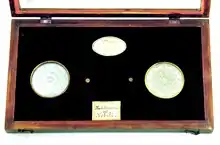Chemical coloring of metals
Chemical coloring of metals is the process of changing the color of metal surfaces with different chemical solutions.
.jpg.webp)


The chemical coloring of metals can be split into two types:
- electroplating - coating the metal surface with another metal using electrolysis.
- patination - chemically reacting the metal surface to form a colored oxide or salt.[1]
Chemically coloring a metal is distinct from simply coating it using a method such as gilding or mercury silvering, because chemical coloring involves a chemical reaction, whereas simple coating does not.
History
The processes of chemical coloring of metals are as old as metalworking technology. Some of the earliest known examples of colored metal objects are about 5000 years old. They are bronze casts with some silver-colored parts, which originate from the Anatolian region. Similar processes can be found on some ancient Egyptian copper sheets.[2] Another example of early chemical coloring of metals is the Nebra sky disk, which has a green patina and gold inlays.
Pliny the Elder mentioned the distinction between naturally occurring and artificial patina in the first century C.E.[3] Another ancient document about the chemical coloring of metals is the Leyden papyrus X (3rd century C.E.).
Two important sources from the Middle Ages on chemically colored metals are the Mappae clavicula, which was dated between the 9th and 12th centuries, and Theophilus Presbyter's work De Diversis Artibus, which was dated to the 12th century.
At the time of the Renaissance, the most significant documents were the Treatise on Goldsmithing and the Treatise on Sculpture by the famous Italian mannerist, sculptor and goldsmith Benvenuto Cellini.[4] Patination is also briefly mentioned by Italian painter and writer Giorgio Vasari and by Pomponius Gauricus in his work De Sculptura 1504. André Felibien also briefly mentions some techniques for patination of bronze sculptures in his work Principes in 1699.[5]
The beginning of modern science-based chemical or electrochemical coloring of metals is marked by Leopoldo Nobili's (1784 - 1835) discovery of Nobilis colored rings in 1826.[6] Leonhard Elsner, Alexander Watt, Antoine César Becquerel (1788 - 1878) and Rudolf Christian Böttger (1806 - 1881) are also important people in the early history of electrochemical coloring of metals. George Richards Elkington (1801 - 1865), known for his patent for the electroplating of silver and gold (1840), had patented at least one electrochemical metal coloring process.[7] In the 19th century, the first manuals dedicated exclusively to the chemical coloring of metals were published.[8] In 1868, Puscher reported on the application of multicolored or lustre patina based on sodium thiosulphate and lead acetate for the first time.[9]
Since the end of the 18th century, chemical coloring of metals has been a regular topic of various collections of chemical technology recipes, and from the mid-19th century onwards, this topic was included in most electroplating manuals and handbooks of goldsmiths and silversmiths.
Great progress was made in the industrial application of chemical coloring of metals in the early 20th century. For example, around 1905, the first patents for black nickel (German patents DRP 183972 and DRP 201663) and black oxide (circa 1915 - 1922, German patents DRP 292603, DRP 357198, DRP 368548) were made. Between 1923 and 1927, the first UK patents relating to oxidised aluminium were published.,[10][11] and black chromium was developed in 1929 (German patent GP 607, 420).
After the Second World War, there was a growing interest in green patinated copper sheets, which were intended primarily for architectural use. Technologies for anodic oxidation of titanium, and later niobium and tantalum, have evolved since the mid-1960s. Technology for the anodic oxidation of stainless steel was developed too in 1957. (patent US 2957812A).[12][13][14]
Now, the possibilities of using bacterial cultures in the patination of copper and iron are being investigated, and laser-induced staining of copper and its alloys, niobium, stainless steel, and chromium plated objects, are being tested.[15][16]
Uses
Chemical coloring of metals is primarily used in the manufacture of sculptures, jewelry, badges, medals, and decorations. It is also used in architecture, in the manufacture of metal furniture, and for military purposes as well as decorative vessels. It is used in the restoration and conservation of metals to some extent.
References
- Fishlock, David: Metal Colouring, Teddington 1962., p.8
- Hughes,R.;Rowe,M. The Colouring,Bronzing and Patination of Metals, London ,1982, page 10
- http://www.che.uc.edu/jensen/W.%20B.%20Jensen/Books/Leyden%20&%20Stockholm%20Papyri.pdf Retrieved 1.01.2018.
- https://archive.org/stream/bub_gb_Gsh2BJGzZLEC#page/n67/mode/2up Retrieved 2.01.2018.
- http://northernlightstudio.com/docs/Patina.doc Retrieved 26.01.2018.
- L. Nobili: Sui colori in generale ed in particolare sopra una nuova scala cromatica dedotta dalla metallocromia ad uso delle scienze e delle arti, Antologia, 39, 117, 1830 e su Bibl. Univ. 15, 337, 1830; e 16, 35, 1830
- Fishlock, David : Metal Colouring,Teddington 1962., page 126
- http://gallica.bnf.fr/ark:/12148/bpt6k6218907f.r=+patines+du+bronze.langFR Retrieved 2.01.2018.
- http://dingler.culture.hu-berlin.de/article/pj190/ar190108 Retrieved 7.02. 2018.
- UK patent 290901, 1927.
- UK patent 223994, 1923
- US Patent Office, http://www.reflectionandrefraction.co.uk/history.html Retrieved 19.01.2018.
- https://pdfpiw.uspto.gov/.piw?Docid=03804730&homeurl=http%3A%2F%2Fpatft.uspto.gov%2Fnetacgi%2Fnph-Parser%3FSect1%3DPTO1%2526Sect2%3DHITOFF%2526d%3DPALL%2526p%3D1%2526u%3D%25252Fnetahtml%25252FPTO%25252Fsrchnum.htm%2526r%3D1%2526f%3DG%2526l%3D50%2526s1%3D3804730.PN.%2526OS%3DPN%2F3804730%2526RS%3DPN%2F3804730&PageNum=&Rtype=&SectionNum=&idkey=NONE&Input=View+first+page .Retrieved May 5th 2020
- https://patents.google.com/patent/US2957812A/en
- https://www.up2europe.eu/european/projects/biological-patina-for-archaeological-and-artistic-metal-artefacts_8707.html Retrieved 15.01.2018.
- B.A. Dajnowski, J. Marczak, A. Sarzyński, M. Strzelec, J.L. Mass, A. Lins, S.I. Shah, R. Murray,T.P. Beebe Jr., Z. Voras Creating Laser Patinas on Copper Alloys: Origins of Colors and Their Implications on Copper Alloys, METAL 2016,New Delhi 2017.,Conference Proceedings ,pages.153 - 160